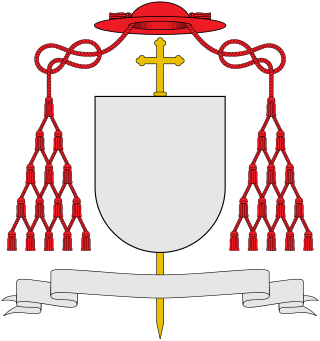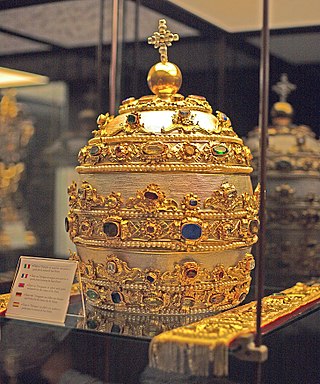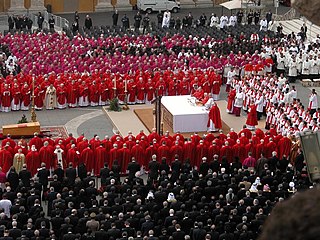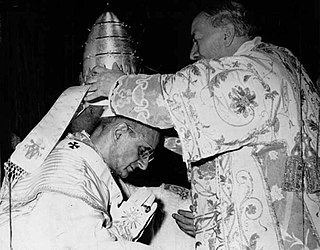| Date | Location | Pope | Cardinal | Deaconry | Notes |
|---|
| 3 October 1143 | Rome | Pope Celestine II | Gregorio Tarquini | SS. Sergio e Bacco | On 26 September he was consecrated bishop of Rome by Cardinal Alberic de Beauvais, bishop of Ostia. |
| 12 March 1144 | Rome | Pope Lucius II | Gregorio Tarquini | SS. Sergio e Bacco | On the same day he was consecrated bishop of Rome by Cardinal Alberic de Beauvais, bishop of Ostia. |
| 14 March 1145 | Abbey of Farfa | Pope Eugenius III | Odone Bonecase | S. Giorgio in Velabro | On 18 February he was consecrated bishop of Rome by Cardinal Corrado della Suburra, bishop of Sabina and dean of the Sacred College of Cardinals. |
| 12 July 1153 | Rome | Pope Anastasius IV | Odone Bonecase | S. Giorgio in Velabro | |
| 5 December 1154 | Rome | Pope Adrian IV | Probably by Cardinal Rodolfo | S. Lucia in Septisolio | Odone Fattiboni was absent (see papal election, 1154) |
| 20 September 1159 | Nympha | Pope Alexander III | Odone Bonecase | S. Giorgio in Velabro | On that same day, he was consecrated bishop of Rome by Cardinal Ubaldo Allucingoli, bishop of Ostia e Velletri. |
| 4 October 1159 | Abbey of Farfa | Antipope Victor IV (1159-1164) | Cardinal Icmar, bishop of Tusculum and dean of the Sacred College of Cardinals | | |
| 22 July 1167 | Rome | Antipope Paschal III | | | On 22 April 1164 he was consecrated bishop of Rome at Lucca by Henry II of Leez prince-bishop of Liège (not a cardinal). |
| 1168 | Rome | Antipope Callistus III | (?) [35] | | |
| 6 September 1181 | Velletri | Pope Lucius III | Teodino de Arrone, bishop of Porto e Santa Rufina. [36] | | |
| 1 December 1185 | Verona | Pope Urban III | (?) (probably by Cardinal Ardicio Rivoltella deacon of S. Teodoro [37] ) | | |
| 25 October 1187 | Ferrara | Pope Gregory VIII | Giacinto Bobone Orsini | S. Maria in Cosmedin | On that same day he was consecrated bishop of Rome, probably by Cardinal Thibaud, bishop of Ostia e Velletri (?). |
| 7 January 1188 | Pisa | Pope Clement III | Giacinto Bobone Orsini | S. Maria in Cosmedin | |
| 14 April 1191 | Rome | Pope Celestine III | Graziano da Pisa | SS. Cosma e Damiano | On that same day he was consecrated bishop of Rome by Cardinal Ottaviano di Paoli, bishop of Ostia e Velletri and sub-dean of the Sacred College of Cardinals |
| 22 February 1198 | Rome | Pope Innocent III | Graziano da Pisa | SS. Cosma e Damiano | On that same day, he was consecrated bishop of Rome by Cardinal Ottaviano di Paoli, bishop of Ostia e Velletri and sub-dean of the Sacred College of Cardinals |
| 31 August 1216 | Rome | Pope Honorius III | Guido Pierleone | S. Nicola in Carcere Tulliano | On 24 July, he was consecrated bishop of Rome by Cardinal Ugolino Conti di Segni, bishop of Ostia e Velletri. |
| 11 April 1227 | Rome | Pope Gregory IX | Ottaviano dei Conti di Segni | SS. Sergio e Bacco | |
| 28 June 1243 | Anagni | Pope Innocent IV | Rainiero Capocci | S. Maria in Cosmedin | On that same day, he was consectrated bishop of Rome, probably by Cardinal Rinaldo Conti di Segni, bishop of Ostia e Velletri and dean of the Sacred College of Cardinals (?). |
| 20 December 1254 | Naples | Pope Alexander IV | Riccardo Annibaldeschi | S. Angelo in Pescheria | |
| 4 September 1261 | Viterbo | Pope Urban IV | Riccardo Annibaldeschi | S. Angelo in Pescheria | |
| 20 September 1265 | Viterbo | Pope Clement IV | Riccardo Annibaldeschi | S. Angelo in Pescheria | |
| 23 March 1272 | Rome | Pope Gregory X | Giovanni Gaetano Orsini | Deacon of S. Nicola in Carcere Tulliano | On 19 March he was consecrated bishop of Rome by (?) (possibly by Cardinal Odo of Châteauroux, bishop of Frascati and dean of the Sacred College of Cardinals). |
| 22 February 1276 | Rome | Pope Innocent V | Giovanni Gaetano Orsini | S. Nicola in Carcere Tulliano | |
| 20 September 1276 | Viterbo | Pope John XXI | Giovanni Gaetano Orsini | S. Nicola in Carcere Tulliano | |
| 26 December 1277 | Rome | Pope Nicholas III | Giacomo Savelli | S. Maria in Cosmedin | On 19 December he was consecrated bishop of Rome by (?) (possibly by Cardinal Bertrand de Saint-Martin, bishop of Sabina and dean of the Sacred College of Cardinals). |
| 23 March 1281 | Orvieto | Pope Martin IV | Giacomo Savelli | S. Maria in Cosmedin | On that same day he was consecrated bishop of Rome by Cardinal Latino Malabranca Orsini, bishop of Ostia e Velletri. |
| 19 May 1285 | Rome | Pope Honorius IV | Goffredo da Alatri | S. Giorgio in Velabro | On that same day he was consecrated bishop of Rome by Cardinal Latino Malabranca Orsini, bishop of Ostia e Velletri. |
| 22 February 1288 | Rome | Pope Nicholas IV | Matteo Orsini Rosso | S. Maria in Portico | |
| 29 August 1294 | Aquila | Pope Celestine V | Probably by Cardinal Matteo Orsini Rosso | S. Maria in Portico | On that same day he was consecrated bishop of Rome probably by Cardinal Hugh Aycelin, bishop of Ostia e Velletri. He was crowned again a few days later (the only instance of a double papal coronation). [1] |
| 23 January 1295 | Rome | Pope Boniface VIII | Matteo Orsini Rosso | S. Maria in Portico | On that same day he was consecrated bishop of Rome by Cardinal Hugh Aycelin, bishop of Ostia e Velletri. |
| 27 October 1303 | Rome | Pope Benedict XI | Matteo Orsini Rosso | S. Maria in Portico | |
| 14 November 1305 | Lyon | Pope Clement V | Napoleone Orsini Frangipani | S. Adriano | |
| 5 September 1316 | Lyon | Pope John XXII | Napoleone Orsini Frangipani | S. Adriano | |
| 15 May 1328 | Rome | Antipope Nicholas V | Giacomo Alberti | pseudocardinal-bishop of Ostia e Velletri | On 12 May he was consecrated bishop of Rome also by Giacomo Alberti, at that time bishop of Castello. |
| 8 January 1335 | Avignon | Pope Benedict XII | Napoleone Orsini Frangipani | S. Adriano | |
| 19 May 1342 | Avignon | Pope Clement VI | Raymond Guillaume des Farges | S. Maria Nuova | |
| 30 December 1352 | Avignon | Pope Innocent VI | Gaillard de la Mothe | S. Lucia in Septisolio | |
| 6 November 1362 | Avignon | Pope Urban V | Probably by Cardinal Guillaume de la Jugié | S. Maria in Cosmedin | On that same day he was consecrated bishop of Rome by Cardinal Andouin Aubert, bishop of Ostia e Velletri. |
| 3 January 1371 | Avignon | Pope Gregory XI | Cardinal Rinaldo Orsini | S. Adriano | On that same day, he was consecrated bishop of Rome by Cardinal Guy de Boulogne, bishop of Porto e Santa Rufina and dean of the Sacred College of Cardinals. |
| 18 April 1378 | Rome | Pope Urban VI | Giacomo Orsini | S. Giorgio in Velabro | |
| 31 October 1378 | Fondi | Antipope Clement VII | Count Onorato I Caetani (not a Cardinal) | | |
| 9 November 1389 | Rome | Pope Boniface IX | Tommaso Orsini | S. Maria in Domnica | On that same day he was consecrated bishop of Rome by Cardinal Francesco Moricotti Prignano, bishop of Palestrina and dean of the Sacred College of Cardinals. |
| 11 October 1394 | Avignon | Antipope Benedict XIII | Hugues de Saint-Martial | S. Maria in Portico | On that same day, he was consecrated bishop of Rome by Cardinal Jean de Neufchâtel, bishop of Ostia e Velletri. |
| 11 November 1404 | Rome | Pope Innocent VII | Rinaldo Brancaccio | SS. Vito e Modesto | |
| 19 December 1406 | Rome | Pope Gregory XII | Probably by Cardinal Rinaldo Brancaccio | SS. Vito e Modesto | |
| 7 July 1409 | Pisa | Antipope Alexander V | Amedeo Saluzzo | S. Maria Nuova | |
| 25 May 1410 | Bologna | Antipope John XXIII | Rinaldo Brancaccio | SS. Vito e Modesto | On that same day, he was consecrated bishop of Rome by Cardinal Jean Allarmet de Brogny, bishop of Ostia e Velletri and sub-dean of the Sacred College of Cardinals. |
| 21 November 1417 | Constance | Pope Martin V | Amedeo Saluzzo | S. Maria Nuova | On 14 November he was consecrated bishop of Rome by Cardinal Jean Allarmet de Brogny, bishop of Ostia e Velletri and dean of the Sacred College of Cardinals. |
| 19 May 1426 | Peñíscola | Antipope Clement VIII | crowned by (?) | | |
| 11 March 1431 | Rome | Pope Eugenius IV | Alfonso Carillo de Albornoz | S. Eustachio | |
| 24 June 1440 | Basel | Antipope Felix V | Cardinal Louis Aleman | S. Cecilia | |
| 19 March 1447 | Rome | Pope Nicholas V | Prospero Colonna | S. Giorgio in Velabro | |
| 20 April 1455 | Rome | Pope Callistus III | Prospero Colonna | S. Giorgio in Velabro | |
| 3 September 1458 | Rome | Pope Pius II | Prospero Colonna | S. Giorgio in Velabro | |
| 16 September 1464 | Rome | Pope Paul II | Niccolò Fortiguerra | S. Cecilia | |
| 25 August 1471 | Rome | Pope Sixtus IV | Rodrigo Borgia | S. Nicola in Carcere Tulliano | On that same day, he was consecrated bishop of Rome by Cardinal Guillaume d'Estouteville, bishop of Ostia e Velletri and sub-dean of the Sacred College of Cardinals. |
| 12 September 1484 | Rome | Pope Innocent VIII | Francesco Todeschini-Piccolomini | S. Eustachio | |
| 26 August 1492 | Rome | Pope Alexander VI | Francesco Todeschini-Piccolomini | S. Eustachio | |
| 8 October 1503 | Rome | Pope Pius III | Raffaele Riario | S. Giorgio in Velabro | On 1 October he was consecrated bishop of Rome by Cardinal Giuliano della Rovere, bishop of Ostia e Velletri and sub-dean of the Sacred College of Cardinals. |
| 26 November 1503 | Rome | Pope Julius II | Raffaele Riario | S. Giorgio in Velabro | |
| 19 March 1513 | Rome | Pope Leo X | Alessandro Farnese | S. Eustachio | On 17 March he was consecrated bishop of Rome by Cardinal Raffaele Riario, bishop of Ostia e Velletri and dean of the Sacred College of Cardinals. |
| 31 August 1522 | Rome | Pope Adrian VI | Marco Cornaro | Santa Maria in Via Lata | |
| 26 November 1523 | Rome | Pope Clement VII | Marco Cornaro | S. Maria in Via Lata | |
| 3 November 1534 | Rome | Pope Paul III | Innocenzo Cibo | S. Maria in Domnica | |
| 22 February 1550 | Rome | Pope Julius III | Innocenzo Cibo | S. Maria in Domnica | |
| 10 April 1555 | Rome | Pope Marcellus II | Jean du Bellay, bishop of Porto e Santa Rufina | | On that same day he was consecrated bishop of Rome by Cardinal Gian Pietro Carafa, bishop of Ostia e Velletri and dean of the Sacred College of Cardinals. |
| 26 May 1555 | Rome | Pope Paul IV | Francesco Pisani | S. Marco | |
| 6 January 1560 | Rome | Pope Pius IV | Alessandro Farnese | S. Lorenzo in Damaso | |
| 17 January 1566 | Rome | Pope Pius V | Giulio Feltre della Rovere | S. Pietro in Vincoli | |
| 25 May 1572 | Rome | Pope Gregory XIII | Girolamo Simoncelli | SS. Cosma e Damiano | |
| 1 May 1585 | Rome | Pope Sixtus V | Ferdinando de' Medici | S. Maria in Domnica | |
| 8 December 1590 | Rome | Pope Gregory XIV | Andreas von Austria | S. Maria Nuova | |
| 3 November 1591 | Rome | Pope Innocent IX | Andreas von Austria | S. Maria Nuova | |
| 9 February 1592 | Rome | Pope Clement VIII | Francesco Sforza di Santa Fiora | S. Maria in Via Lata | On 2 February he was consecrated bishop of Rome by Cardinal Alfonso Gesualdo, bishop of Ostia e Velletri and dean of the Sacred College of Cardinals. |
| 10 April 1605 | Rome | Pope Leo XI | Francesco Sforza di Santa Fiora | S. Maria in Via Lata | |
| 29 May 1605 | Rome | Pope Paul V | Francesco Sforza di Santa Fiora | S. Maria in Via Lata | |
| 14 February 1621 | Rome | Pope Gregory XV | Andrea Baroni Peretti Montalto | S. Maria in Via Lata | |
| 29 September 1623 | Rome | Pope Urban VIII | Alessandro d'Este | S. Maria in Via Lata | |
| 4 October 1644 | Rome | Pope Innocent X | Carlo de Medici | S. Nicola in Carcere Tulliano | |
| 16 April 1655 | Rome | Pope Alexander VII | Gian Giacomo Teodoro Trivulzio | S. Maria in Via Lata | |
| 26 June 1667 | Rome | Pope Clement IX | Rinaldo d'Este | S. Nicola in Carcere Tulliano | |
| 11 May 1670 | Rome | Pope Clement X | Francesco Maidalchini | S. Maria in Via Lata | |
| 4 October 1676 | Rome | Pope Innocent XI | Francesco Maidalchini | S. Maria in Via Lata | |
| 16 October 1689 | Rome | Pope Alexander VIII | Francesco Maidalchini | S. Maria in Via Lata | |
| 15 July 1691 | Rome | Pope Innocent XII | Urbano Sacchetti | S. Maria in Via Lata | |
| 8 December 1700 | Rome | Pope Clement XI | Benedetto Pamphilj | S. Maria in Via Lata | On 30 November he was consecrated bishop of Rome by Cardinal de Bouillon, bishop of Porto e Santa Rufina and dean of the Sacred College of Cardinals. |
| 18 May 1721 | Rome | Pope Innocent XIII | Benedetto Pamphilj | S. Maria in Via Lata | |
| 4 June 1724 | Rome | Pope Benedict XIII | Benedetto Pamphilj | S. Maria in Via Lata | |
| 16 July 1730 | Rome | Pope Clement XII | Lorenzo Altieri | S. Maria in Via Lata | |
| 21 August 1740 | Rome | Pope Benedict XIV | Carlo Maria Marini | S. Maria in Via Lata |
| 16 July 1758 | Rome | Pope Clement XIII | Alessandro Albani | S. Maria in Via Lata | |
| 4 June 1769 | Rome | Pope Clement XIV | Alessandro Albani | S. Maria in Via Lata | On 28 May he was consecrated bishop of Rome by Cardinal Federico Marcello Lante, bishop of Porto e Santa Rufina and sub-dean of the Sacred College of Cardinals. |
| 22 February 1775 | Rome | Pope Pius VI | Alessandro Albani | S. Maria in Via Lata | On that same day, he was consecrated bishop of Rome by Cardinal Giovanni Francesco Albani, bishop of Porto e Santa Rufina and dean of the Sacred College of Cardinals. |
| 21 March 1800 | Venice | Pope Pius VII | Antonio Doria Pamphili | S. Maria ad Martyres | |
| 5 October 1823 | Rome | Pope Leo XII | Fabrizio Ruffo | S. Maria in Via Lata | |
| 5 April 1829 | Rome | Pope Pius VIII | Giuseppe Albani | S. Maria in Via Lata | |
| 6 February 1831 | Rome | Pope Gregory XVI | Giuseppe Albani | S. Maria in Via Lata | On that same day he was consecrated bishop of Rome by Cardinal Bartolomeo Pacca, bishop of Ostia e Velletri and dean of the Sacred College of Cardinals. |
| 21 June 1846 | Rome | Pope Pius IX | Tommaso Riario Sforza | S. Maria in Via Lata | |
| 3 March 1878 | Rome | Pope Leo XIII | Teodolfo Mertel | S. Eustachio | Teodolfo Mertel as the second senior cardinal-deacon, assumed the protodeacon's responsibilities at the coronation due to the illness of Prospero Caterini the incumbent protodeacon [38] [39] |
| 9 August 1903 | Rome | Pope Pius X | Luigi Macchi | S. Maria in Via Lata | |
| 6 September 1914 | Rome | Pope Benedict XV | Francesco Salesio Della Volpe | S. Maria in Aquiro | |
| 12 February 1922 | Rome | Pope Pius XI | Gaetano Bisleti | S. Agata in Suburra | |
| 12 March 1939 | Rome, Vatican City | Pope Pius XII | Camillo Caccia-Dominioni | S. Maria in Domnica | |
| 4 November 1958 | Rome, Vatican City | Pope John XXIII | Nicola Canali | S. Nicola in Carcere Tulliano | |
| 30 June 1963 | Rome, Vatican City | Pope Paul VI | Alfredo Ottaviani | S. Maria in Domnica | |


















